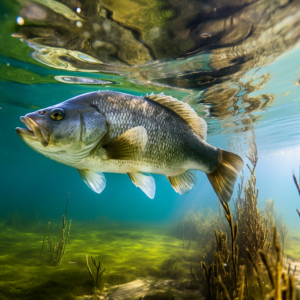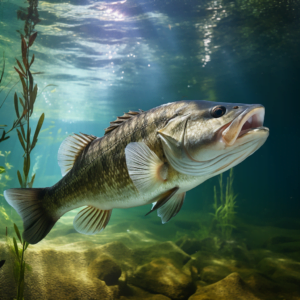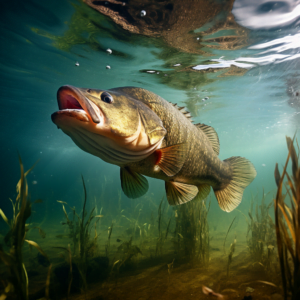Have you ever wondered how old a 5 lb largemouth bass is? It’s an interesting question, isn’t it? When you think about it, fish can live for quite a long time, but does that mean a 5 lb bass is necessarily old? In this article, we will dive into the world of fish and explore the age of a 5 lb largemouth bass in more detail.
Fish, as a species, have a reputation for being quite long-lived. Some species of fish can live for several decades, while others may only live for a few years. The age of a 5 lb largemouth bass can vary depending on various factors such as their environment, diet, and genetics.
To truly understand the age of a 5 lb largemouth bass, we need to take a closer look at its growth rate. Largemouth bass, like many other fish species, tend to grow at a slower rate as they age. This means that a 5 lb bass could be relatively young or quite old, depending on how quickly it has grown.
In our upcoming article, we will delve into the science behind determining the age of fish, particularly largemouth bass. We will explore the various methods researchers use to estimate fish age, such as analyzing scales, otoliths (ear stones), and growth rings. By the end of the article, you’ll have a better understanding of just how old a 5 lb largemouth bass might be and why fish age is such a fascinating topic.
The Age of a 5 lb Largemouth Bass
What Determines the Age of a Largemouth Bass?
Determining the age of a largemouth bass can be a fascinating endeavor. It is a question that many anglers and researchers have asked themselves over the years. The age of a largemouth bass can be determined by studying its growth rings, much like how you would determine the age of a tree by looking at its rings. These growth rings, also known as annuli, form on the fish’s scales and otoliths, which are structures found in the fish’s inner ear.
Factors Affecting the Growth Rate of Largemouth Bass
The growth rate of a largemouth bass can be influenced by various factors, including environmental conditions, availability of food, genetics, and competition with other fish species. Temperature plays a significant role in the growth of largemouth bass, as they are ectothermic animals, meaning that their body temperature is regulated by external sources. Warmer water temperatures have been found to accelerate the growth rate of largemouth bass, while colder water temperatures can slow it down.
The Relationship Between Weight and Age of Largemouth Bass
The relationship between weight and age in largemouth bass is not a straightforward one. While it is generally believed that largemouth bass grow larger as they get older, the rate at which they gain weight can differ between individuals. Factors such as genetics, available food resources, and competition can all impact the rate of weight gain in largemouth bass. Therefore, it is essential to consider multiple factors when trying to estimate the age of a 5 lb largemouth bass.
How to Estimate the Age of a 5 lb Largemouth Bass?
Estimating the age of a 5 lb largemouth bass can be a challenging task, but it is not impossible. One method used by researchers is the examination of the fish’s otoliths, which are small calcified structures found in their inner ears. Otoliths have rings that can be counted, similar to the rings on a tree. Each ring represents one year of the fish’s life. By carefully removing and examining the otoliths under a microscope, researchers can determine the age of the largemouth bass.
Another method used to estimate the age of largemouth bass is by studying their scales. Similar to otoliths, scales also have rings that can indicate the age of the fish. However, the scales can be more challenging to interpret than otoliths, as they are subject to growth irregularities and can be easily damaged. Researchers often combine both otolith and scale analysis to get a more accurate estimation of the age of a largemouth bass.
The Importance of Determining the Age of Largemouth Bass
Understanding the age of largemouth bass is crucial for various reasons. By studying the age structure of a largemouth bass population, researchers can gain insights into the overall health and vitality of the fishery. It can help assess the impacts of fishing pressure, habitat degradation, and climate change on the population. Additionally, knowing the age of a largemouth bass can also provide valuable information for management and conservation efforts.
Research Methods for Age Determination in Largemouth Bass
As mentioned earlier, the examination of otoliths and scales is the most common method used to determine the age of a largemouth bass. However, other techniques, such as genetic testing and growth modeling, are also being explored. Genetic testing can help determine the parentage of individual fish and provide insights into the population structure and genetic diversity. Growth modeling, on the other hand, involves collecting data on fish size and growth rates over time to create mathematical models that can estimate the age of fish based on their size.
Understanding the Life Cycle of Largemouth Bass
To fully grasp the age of a largemouth bass, it is essential to understand its life cycle. Largemouth bass typically spawn in the spring when water temperatures reach around 60-75 degrees Fahrenheit. The male bass build nests in shallow water, usually near structures such as submerged vegetation or rocks. The female bass will lay their eggs, and the male will guard the nest until the fry hatch. The fry will then grow rapidly, feeding on zooplankton and small invertebrates. As they grow, their diet will shift to include larger prey such as small fish and crayfish.
Implications of Overfishing on Largemouth Bass Population
Overfishing can have severe implications on largemouth bass populations. When too many fish are harvested, it can disrupt the balance of the ecosystem and lead to a decline in their numbers. Additionally, overfishing can result in the removal of larger, older fish, which are essential for maintaining genetic diversity and reproductive success. It is crucial to manage largemouth bass populations sustainably by implementing catch limits, size restrictions, and conservation measures.
Conservation Efforts for Maintaining Largemouth Bass Population
To ensure the long-term preservation of largemouth bass populations, various conservation efforts are being implemented. These efforts include habitat restoration, creation of spawning grounds, and the establishment of protected areas. Additionally, educating anglers about responsible fishing practices, catch-and-release techniques, and the importance of conservation can go a long way in protecting largemouth bass populations for future generations.
Conclusion
Determining the age of a 5 lb largemouth bass may not be an exact science, but it is a worthwhile pursuit. By understanding the factors that affect the growth rate of largemouth bass and employing various research methods, we can gain valuable insights into their age, health, and overall population dynamics. Protecting and conserving largemouth bass populations are essential for maintaining healthy ecosystems and ensuring a sustainable future for these magnificent fish. So the next time you catch a 5 lb largemouth bass, take a moment to appreciate its age and the remarkable journey it has undertaken.




